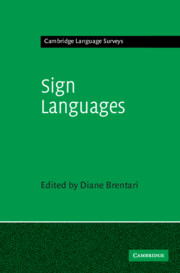Book contents
- Frontmatter
- Contents
- List of figures
- List of tables
- List of contributors
- List of sign language abbreviations
- Notational conventions
- 1 Introduction
- I HISTORY AND TRANSMISSION
- 2 Transmission of sign languages in Northern Europe
- 3 Transmission of sign languages in Latin America
- 4 Transmission of sign languages in the Nordic countries
- 5 Transmission of sign languages in Mediterranean Europe
- 6 Transmission of sign languages in Africa
- 7 Transmission of Polish sign systems
- II SHARED CROSSLINGUISTIC CHARACTERISTICS
- III VARIATION AND CHANGE
- Notes
- References
- Index
7 - Transmission of Polish sign systems
from I - HISTORY AND TRANSMISSION
Published online by Cambridge University Press: 05 June 2012
- Frontmatter
- Contents
- List of figures
- List of tables
- List of contributors
- List of sign language abbreviations
- Notational conventions
- 1 Introduction
- I HISTORY AND TRANSMISSION
- 2 Transmission of sign languages in Northern Europe
- 3 Transmission of sign languages in Latin America
- 4 Transmission of sign languages in the Nordic countries
- 5 Transmission of sign languages in Mediterranean Europe
- 6 Transmission of sign languages in Africa
- 7 Transmission of Polish sign systems
- II SHARED CROSSLINGUISTIC CHARACTERISTICS
- III VARIATION AND CHANGE
- Notes
- References
- Index
Summary
Introduction
This chapter will discuss the overall context in Poland in which “non hearing” persons live and work, and also the modes of transmission of sign systems in Poland, including what will be referred to as the natural variety of Polish Sign Language (PJM, polski język migowy), which has arisen organically from interactions from within this community. The goal of this chapter is to bring forth the specificity of the Polish condition and its dilemmas.
Non-hearing persons living in Poland constitute a unique community worthy of its own description and examination. They are a diverse group, both in terms of their functional language performance as well as their various social properties. Unfortunately, broad conclusions about the deaf community are often drawn from singular phenomenon, small non-representative samples, or even individual cases. The conclusions derived in such a matter can be quite harmful, for “individual features cannot be representative of a collective” (Babiński 1998:13); they can only be characteristic of a specific number or group of people.
The assessment of “non-hearing” environments in Poland is typically based on data derived from pedagogical and applied linguistics research, which tends to focus more on spoken rather than signed language. Moreover, scholarly works about this community tends to focus on practical applications for the education of non-hearing persons, and there is more attention on deaf education (surdo-pedagogy) rather than on deaf studies (surdo-logy).
- Type
- Chapter
- Information
- Sign Languages , pp. 131 - 148Publisher: Cambridge University PressPrint publication year: 2010
- 5
- Cited by

